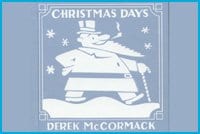Did you know Canadians used to sprinkle asbestos for fake snow? Or that poor children died climbing holly trees trying to make money from the branches? Or that Christmas crackers and trees, Santa suits and parade floats kept our fire brigades in business?
Perhaps Derek McCormack’s Christmas Days would be more aptly named Dangers Of Christmas Past. This excellently researched book chronicles the minutiae of Canadian Christmas history from the 1800s to the present, supplying its readers with impressive factoids to relate at holiday dinners (especially those they want to ruin).
But McCormack has created something infinitely superior to trivia. In tight, poetic prose he weaves a funny and insightful tale of this quirky country. What slowly emerges is indeed a picture of our collective stupidity — did we really deforest the old growth of the Maritimes for one day of pleasure? — but also a picture of a people desperate for beauty and passionate about generosity.
McCormack combines quotes from newspapers, magazines and catalogues with hilarious, heartwarming interviews. Santa costume seamstresses, doll repairers, Santaland designers, tree farmers and professional Clauses make memorable appearances. McCormack’s interviews with Santa Victor, who runs a Santa school and has an almost obsessive dedication to his role, are fascinating. For a moment I actually forgot about capitalism.
In case we might be too generous with Canadians, who raise money to fight lung disease through Christmas seals programs and ensure that every letter to the North Pole is answered, McCormack reminds us of debacles, like our disastrous 1929 reindeer-breeding campaign. Originally designed to feed the starving Inuvialuit after white people decimated the caribou, the program ended with a smattering of herds used for Christmas displays and commercial meat (neither of which benefited the Inuvialuit).
Stunningly illustrated and designed by graphic genius Seth, Christmas Days is more than worthy of collection. I have to admit, though, that McCormack’s superb research made me want historical photos, too. The Santa we know, for example, was standardized by Coca-Cola in the 1930s. Before, Santa was elven and dressed in a variety of colours and costumes; he was even outfitted in Union suits after the US civil war. I wanted pictures of a skinny-ass Santa, of factory workers who had to stuff toys into sharp net Christmas stockings, of Santa Victor in all his glory.
Each of 24 chapters covers a secular phenomenon: fake snow, dinner, parades, lights. Designed like an Advent calendar — a treat every day. Several chapters falter slightly under this constraint; sections on wrapping paper, bows and corsages aren’t too gripping. But McCormack has a flair for non-fiction. His writing flows melodiously and is peppered with poetic devices, witty puns and terse sentences that give one pause. He also seamlessly weaves in personal anecdotes, creating a cumulative feeling of community.
As a bah-humbugger who has a hard time seeing unity in Canada, I was thoroughly engrossed. This book is a perfect gift for lovers and haters of Christmas alike.

 Why you can trust Xtra
Why you can trust Xtra


